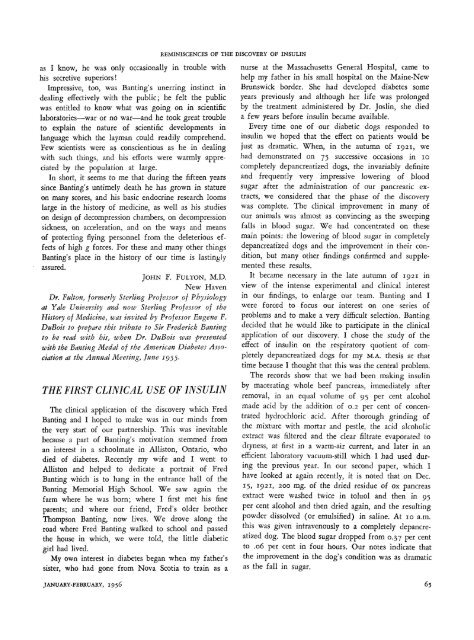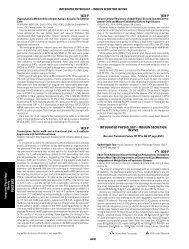Reminiscences of the Discovery of Insulin - Diabetes
Reminiscences of the Discovery of Insulin - Diabetes
Reminiscences of the Discovery of Insulin - Diabetes
You also want an ePaper? Increase the reach of your titles
YUMPU automatically turns print PDFs into web optimized ePapers that Google loves.
as I know, he was only occasionally in trouble with<br />
his secretive superiors!<br />
Impressive, too, was Banting's unerring instinct in<br />
dealing effectively with <strong>the</strong> public; he felt <strong>the</strong> public<br />
was entitled to know what was going on in scientific<br />
laboratories—war or no war—and he took great trouble<br />
to explain <strong>the</strong> nature <strong>of</strong> scientific developments in<br />
language which <strong>the</strong> layman could readily comprehend.<br />
Few scientists were as conscientious as he in dealing<br />
with such things, and his efforts were warmly appreciated<br />
by <strong>the</strong> population at large.<br />
In short, it seems to me that during <strong>the</strong> fifteen years<br />
since Banting's untimely death he has grown in stature<br />
on many scores, and his basic endocrine research looms<br />
large in <strong>the</strong> history <strong>of</strong> medicine, as well as his studies<br />
on design <strong>of</strong> decompression chambers, on decompression<br />
sickness, on acceleration, and on <strong>the</strong> ways and means<br />
<strong>of</strong> protecting flying personnel from <strong>the</strong> deleterious effects<br />
<strong>of</strong> high g forces. For <strong>the</strong>se and many o<strong>the</strong>r things<br />
Banting's place in <strong>the</strong> history <strong>of</strong> our time is lastingly<br />
assured.<br />
REMINISCENCES OF THE DISCOVERY OF INSULIN<br />
JOHN F. FULTON,<br />
M.D.<br />
New Haven<br />
Dr. Fulton, formerly Sterling Pr<strong>of</strong>essor <strong>of</strong> Physiology<br />
at Yale University and now Sterling Pr<strong>of</strong>essor <strong>of</strong> <strong>the</strong><br />
History <strong>of</strong> Medicine, was invited by Pr<strong>of</strong>essor Eugene F.<br />
DuBois to prepare this tribute to Sir Frederick Banting<br />
to be read with his, when Dr. DuBois was presented<br />
with <strong>the</strong> Banting Medal <strong>of</strong> <strong>the</strong> American <strong>Diabetes</strong> Association<br />
at <strong>the</strong> Annual Meeting, ]une 1955-<br />
THE FIRST CLINICAL USE OF INSULIN<br />
The clinical application <strong>of</strong> <strong>the</strong> discovery which Fred<br />
Banting and I hoped to make was in our minds from<br />
<strong>the</strong> very start <strong>of</strong> our partnership. This was inevitable<br />
because a part <strong>of</strong> Banting's motivation stemmed from<br />
an interest in a schoolmate in Alliston, Ontario, who<br />
died <strong>of</strong> diabetes. Recently my wife and I went to<br />
Alliston and helped to dedicate a portrait <strong>of</strong> Fred<br />
Banting which is to hang in <strong>the</strong> entrance hall <strong>of</strong> <strong>the</strong><br />
Banting Memorial High School. We saw again <strong>the</strong><br />
farm where he was born; where I first met his fine<br />
parents; and where our friend, Fred's older bro<strong>the</strong>r<br />
Thompson Banting, now lives. We drove along <strong>the</strong><br />
road where Fred Banting walked to school and passed<br />
<strong>the</strong> house in which, we were told, <strong>the</strong> little diabetic<br />
girl had lived.<br />
My own interest in diabetes began when my fa<strong>the</strong>r's<br />
sister, who had gone from Nova Scotia to train as a<br />
JANUARY-FEBRUARY, 1956<br />
nurse at <strong>the</strong> Massachusetts General Hospital, came to<br />
help my fa<strong>the</strong>r in his small hospital on <strong>the</strong> Maine-New<br />
Brunswick border. She had developed diabetes some<br />
years previously and although her life was prolonged<br />
by <strong>the</strong> treatment administered by Dr. Joslin, she died<br />
a few years before insulin became available.<br />
Every time one <strong>of</strong> our diabetic dogs responded to<br />
insulin we hoped that <strong>the</strong> effect on patients would be<br />
just as dramatic. When, in <strong>the</strong> autumn <strong>of</strong> 1921, we<br />
had demonstrated on 75 successive occasions in 10<br />
completely depancreatized dogs, <strong>the</strong> invariably definite<br />
and frequently very impressive lowering <strong>of</strong> blood<br />
sugar after <strong>the</strong> administration <strong>of</strong> our pancreatic extracts,<br />
we considered that <strong>the</strong> phase <strong>of</strong> <strong>the</strong> discovery<br />
was complete. The clinical improvement in many <strong>of</strong><br />
our animals was almost as convincing as <strong>the</strong> sweeping<br />
falls in blood sugar. We had concentrated on <strong>the</strong>se<br />
main points: <strong>the</strong> lowering <strong>of</strong> blood sugar in completely<br />
depancreatized dogs and <strong>the</strong> improvement in <strong>the</strong>ir condition,<br />
but many o<strong>the</strong>r findings confirmed and supplemented<br />
<strong>the</strong>se results.<br />
It became necessary in <strong>the</strong> late autumn <strong>of</strong> 1921 in<br />
view <strong>of</strong> <strong>the</strong> intense experimental and clinical interest<br />
in our findings, to enlarge our team. Banting and I<br />
were forced to focus our interest on one series <strong>of</strong><br />
problems and to make a very difficult selection. Banting<br />
decided that he would like to participate in <strong>the</strong> clinical<br />
application <strong>of</strong> our discovery. I chose <strong>the</strong> study <strong>of</strong> <strong>the</strong><br />
effect <strong>of</strong> insulin on <strong>the</strong> respiratory quotient <strong>of</strong> completely<br />
depancreatized dogs for my M.A. <strong>the</strong>sis at that<br />
time because I thought that this was <strong>the</strong> central problem.<br />
The records show that we had been making insulin<br />
by macerating whole beef pancreas, immediately after<br />
removal, in an equal volume <strong>of</strong> 95 per cent alcohol<br />
made acid by <strong>the</strong> addition <strong>of</strong> 0.2 per cent <strong>of</strong> concentrated<br />
hydrochloric acid. After thorough grinding <strong>of</strong><br />
<strong>the</strong> mixture with mortar and pestle, <strong>the</strong> acid alcoholic<br />
extract was filtered and <strong>the</strong> clear filtrate evaporated to<br />
dryness, at first in a warm-air current, and later in an<br />
efficient laboratory vacuum-still which I had used during<br />
<strong>the</strong> previous year. In our second paper, which I<br />
have looked at again recently, it is noted that on Dec.<br />
15, 1921, 200 mg. <strong>of</strong> <strong>the</strong> dried residue <strong>of</strong> ox pancreas<br />
extract were washed twice in toluol and <strong>the</strong>n in 95<br />
per cent alcohol and <strong>the</strong>n dried again, and <strong>the</strong> resulting<br />
powder dissolved (or emulsified) in saline. At 10 a.m.<br />
this was given intravenously to a completely depancreatized<br />
dog. The blood sugar dropped from 0.37 per cent<br />
to .06 per cent in four hours. Our notes indicate that<br />
<strong>the</strong> improvement in <strong>the</strong> dog's condition was as dramatic<br />
as <strong>the</strong> fall in sugar.
















